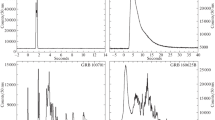Abstract
Much of the progress in understanding γ-ray bursts (GRBs) has come from studies of distant events (redshift z ≈ 1). In the brightest GRBs, the γ-rays are so highly collimated that the events can be seen across the Universe. It has long been suspected that the nearest and most common events have been missed because they are not as collimated or they are under-energetic (or both)1. Here we report soft γ-ray observations of GRB 031203, the nearest event to date (z = 0.106; ref. 2). It had a duration of 40 s and peak energy of >190 keV, and therefore appears to be a typical long-duration GRB. The isotropic γ-ray energy of ≤1050 erg, however, is about three orders of magnitude smaller than that of the cosmological population. This event—as well as the other nearby but somewhat controversial GRB 980425—is a clear outlier from the isotropic-energy/peak-energy relation3,4 and luminosity/spectral-lag relations5,6 that describe the majority of GRBs. Radio calorimetry shows that both of these events are under-energetic explosions7. We conclude that there does indeed exist a large population of under-energetic events.



Similar content being viewed by others
References
MacFadyen, A. I., Woosley, S. E. & Heger, A. Supernovae, jets and collapsars. Astrophys. J. 550, 410–425 (2001)
Prochaska, J. X. et al. The host galaxy of GRB 031203: implications of its low metallicity, low redshift, and starburst nature. Astrophys. J. (in the press)
Amati, L. et al. Intrinsic spectra and energetics of BeppoSAX gamma-ray bursts with known redshifts. Astron. Astrophys. 390, 81–89 (2002)
Lamb, D. Q., Donaghy, T. Q. & Graziani, C. A unified jet model of X-ray flashes and γ-ray bursts. New Astron. Rev. 48, 459–464 (2004)
Norris, J. P., Marani, G. F. & Bonnell, J. T. Connection between energy-dependent lags and peak luminosity in gamma-ray bursts. Astrophys. J. 534, 248–257 (2000)
Schaefer, B. E., Deng, M. & Band, D. L. Redshifts and luminosities for 112 gamma-ray bursts. Astrophys. J. 563, L123–L127 (2001)
Soderberg, A. M. et al. The sub-energetic γ-ray burst GRB 031203 as a cosmic analogue to the nearby GRB 980425. Nature doi:10.1038/nature02757 (this issue)
Mereghetti, S. & Götz, D. GRB 031203: further analysis of INTEGRAL data. GCN Circ., 2460 (2003)
Götz, D., Mereghetti, S., Beck, M., Borkowski, J. & Mowlavi, N. GRB 031203: a long GRB detected with INTEGRAL. GCN Circ. 2459 (2003)
Watson, D. et al. A very low luminosity X-ray flash: XMM-Newton observations of GRB 031203. Astrophys. J. 605, L101–L104 (2004)
Heise, J., in't Zand, J., Kippen, R. M. & Woods, P. M. in Gamma-ray Bursts in the Afterglow Era (eds Costa, E., Frontera, F. & Hjorth, J.) 16–21 (Springer, Berlin/Heidelberg, 2001)
Barraud, C. et al. Spectral analysis of 35 GRBs/XRFs observed with HETE-2/FREGATE. Astron. Astrophys. 400, 1021–1030 (2003)
Vaughan, S. et al. The discovery of an evolving dust-scattered X-ray halo around GRB 031203. Astrophys. J. 603, L5–L8 (2004)
Galama, T. J. et al. An unusual supernova in the error box of the gamma-ray burst of 25 April 1998. Nature 395, 670–672 (1998)
Kulkarni, S. R. et al. Radio emission from the unusual supernova 1998bw and its association with the gamma-ray burst of 25 April 1998. Nature 395, 663–669 (1998)
Bloom, J. S. et al. Expected characteristics of the subclass of supernova gamma-ray bursts. Astrophys. J. 506, L105–L108 (1998)
Yamazaki, R., Yonetoku, D. & Nakamura, T. An off-axis jet model for GRB 980425 and low-energy gamma-ray bursts. Astrophys. J. 594, L79–L82 (2003)
Soderberg, A. M., Frail, D. A. & Wieringa, M. H. Constraints on off-axis gamma-ray burst jets in type Ibc supernovae from late-time radio observations. Astrophys. J. 607, L13–L16 (2004)
Paciesas, W. S. et al. The fourth BATSE gamma-ray burst catalog (revised). Astrophys. J. Suppl. Ser. 122, 465–495 (1999)
Mazets, E. P. & Golenetskii, S. V. Recent results from the gamma-ray burst studies in the KONUS experiment. Astrophys. Space Sci. 75, 47–81 (1981)
Kuznetsov, A. V. et al. SIGNE:2 MP9 data for the powerful gamma-ray burst of 1983 Aug 1. Sov. Astron. Lett. 12, 315–318 (1986)
Fenimore, E. E. et al. The intrinsic luminosity of gamma-ray bursts and their host galaxies. Nature 366, 40–42 (1993)
Lutovinov, A. A., Molkov, S. V. & Revnivtsev, M. G. The first results of observations of the transient pulsar SAX J2103.5 + 4545 by the INTEGRAL observatory. Astron. Lett. 29, 713–718 (2003)
Revnivtsev, M. G. et al. A hard X-ray survey of the Galactic-Center region with the IBIS telescope of the INTEGRAL observatory: a catalog of sources. Astron. Lett. 30, 430–435 (2004)
Mazets, E. P. et al. Cosmic gamma-ray burst spectroscopy. Astrophys. Space Sci. 82, 261–282 (1982)
Band, D. et al. BATSE observations of gamma-ray burst spectra. I - Spectral diversity. Astrophys. J. 413, 281–292 (1993)
Schaefer, B. E. Gamma-ray burst Hubble diagram to z = 4.5. Astrophys. J. 583, L67–L70 (2003)
Acknowledgements
This work is based on a Core Programme pointed observation (PI: S.Yu.S.) with INTEGRAL, an ESA project with instruments and science data centre funded by ESA member states (especially the PI countries: Denmark, France, Germany, Italy, Switzerland, Spain), Czech Republic and Poland, and with the participation of Russia and the USA. We thank M. Revnivtsev and E. Churazov for help in the data analysis, and S. Kulkarni for suggestions.
Author information
Authors and Affiliations
Corresponding author
Ethics declarations
Competing interests
The authors declare that they have no competing financial interests.
Rights and permissions
About this article
Cite this article
Sazonov, S., Lutovinov, A. & Sunyaev, R. An apparently normal γ-ray burst with an unusually low luminosity. Nature 430, 646–648 (2004). https://doi.org/10.1038/nature02748
Received:
Accepted:
Issue Date:
DOI: https://doi.org/10.1038/nature02748
- Springer Nature Limited
This article is cited by
-
Detection of short high-energy transients in the local universe with SVOM/ECLAIRs
Astrophysics and Space Science (2020)
-
Relativistic ejecta from X-ray flash XRF 060218 and the rate of cosmic explosions
Nature (2006)
-
An optical supernova associated with the X-ray flash XRF 060218
Nature (2006)
-
A faint population of bursts?
Nature (2004)





